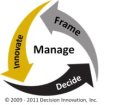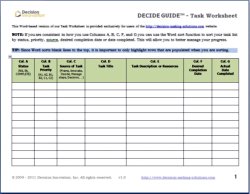Decision implementation - Get the desired results during the Manage step
 Decision implementation is where thought moves to reality. In the previous steps of the decision making process, Frame, Innovate, and Decide, work has focused on generating the clarity for an outcome that will be achieved in the future. In the Manage step, the focus moves from clarifying needs/desires and decision alternatives to decision implementation, generating the envisioned results from the previous steps of the process.
Decision implementation is where thought moves to reality. In the previous steps of the decision making process, Frame, Innovate, and Decide, work has focused on generating the clarity for an outcome that will be achieved in the future. In the Manage step, the focus moves from clarifying needs/desires and decision alternatives to decision implementation, generating the envisioned results from the previous steps of the process.
Rarely does a decision sit in isolation. Decisions provide limits for or are constrained by other decisions as shown in our decision making model (also see specific decision networks for business, personal, and consumer). Each choice we make is part of this integrated network, influencing or being influenced by the other decisions we have made implicitly or explicitly.

Decision implementation requires managing the consequences of these networks of related decisions to achieve our desired purpose or intent, individually or as part of an organization. As our three-arrow process logo suggests, the Manage step (shown in the middle) is the set of ongoing activities that manages tasks and communication associated with individual decisions as well as the overall decision network.
Decision implementation - Managing consequences
Decisions lead to two types of consequences: actions or tasks that result from the chosen solution alternative(s), and guiding requirements that can lead to follow-on decisions needed to implement the current decision. It is important to note that a decision that is not implemented (resourced, funded, acted upon, ...) will not generate the desired future result!
Here are some questions that can help you identify possible consequences for a specific decision.
- What business or personal relationships might be impacted?
- What actions or tasks are required to implement the chosen solution alternative?
- Are there other decisions to be made to make the chosen solution a reality?
- Does the chosen alternative have an impact on, or cause a conflict with, previously made decisions? If so, what decisions need to be revisited?
- Who needs to know about the decision? Consider the stakeholders list created during planning decision making.
- What actions or tasks will be required to make the transition to the envisioned new solution when decision implementation is complete? How do you deal with moving from the current state to the new state?
Guiding requirements lead to additional decisions that can be managed using our decision making process. Before focusing on tasks, we need to address the risks and opportunities for the selected solution(s).
Addressing the risks and opportunities during decision implementation

For each risk and opportunity identified in the Decide step, create any tasks that you can think of that would help reduce the risks or enhance the opportunities. Risk and opportunity actions can be handled in three possible ways and the tasks need to be appropriate for the chosen risk mitigation or opportunity acceleration approach:
- Monitoring Actions: Define a task that will help you monitor the situation for some indication that the risk or opportunity is about to occur or has occurred. Once a risk or opportunity becomes a reality, new decisions and actions will likely be required if the situation and facts supporting the original decision alternative have changed. Monitoring actions can also be used to trigger conditional actions.
- Preventative or Acceleration Actions: Define a task that would help prevent a risk or accelerate an opportunity.
- Conditional Actions: Define a task that would put something in place in advance that will deal with a risk or opportunity dynamically.
For high impact and high probability risks it may be necessary to have all three types of actions in place to increase the likelihood of decision implementation success.
The key to decision management - completing the tasks
It is now time to complete the work you have started as you identified tasks during each step of the decision making process. It is through the actions and tasks identified that decision implementation is realized.
Here is the information that should be captured for each task to enable management of all the tasks needed for success.

- Task Title
- Description of task - This needs to be sufficient for the person doing the work to be able to understand the work that needs to be done and what resources may be needed.
- Status - Not started, in progress, or complete
- Priority - A's; do first, B's; do soon, C's; not time critical
- Source of task - This can be used to help determine priority. Also, if the situation changes the task may no longer be needed.
- Desired completion date - Set a target that enables success for the chosen solution.
- Actual completion date - Capture the date when the task was completed.
A worksheet can be used to prioritize and manage the tasks that lead to decision realization. As you start to make progress on your tasks, expect to add, subtract, and modify the tasks based on new knowledge. Once a task list is in place, it can be used to manage the other connected decisions associated with a specific decision implementation.
Business decision management often has impacts across projects and organizations and is most effectively addressed using the project management tools currently in use within the business.
Successful decision implementation usually requires communication
Most high value decisions will impact a number of people. Using the list of stakeholders identified in the Frame step, it makes sense to develop some mechanisms for communications with your stakeholders as part of your on-going decision management.
Decision management is almost always enhanced by maintaining good communication. Effective communication during the decision making process will help minimize resistance, reduce negative emotions, and enlist support for necessary changes and actions. Plan and include communication as part of the Manage step activities.

Return from Decision implementation to Decision Making Process
